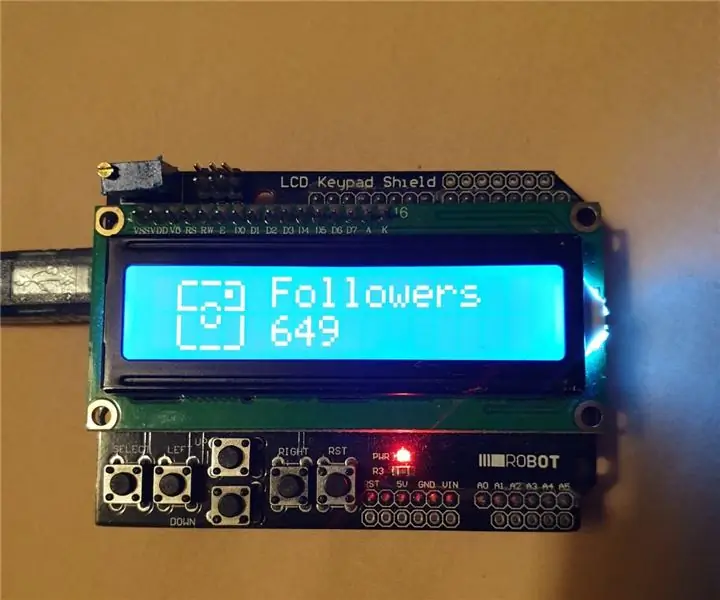
Inhaltsverzeichnis:
- Autor John Day [email protected].
- Public 2024-01-30 07:19.
- Zuletzt bearbeitet 2025-01-23 12:52.
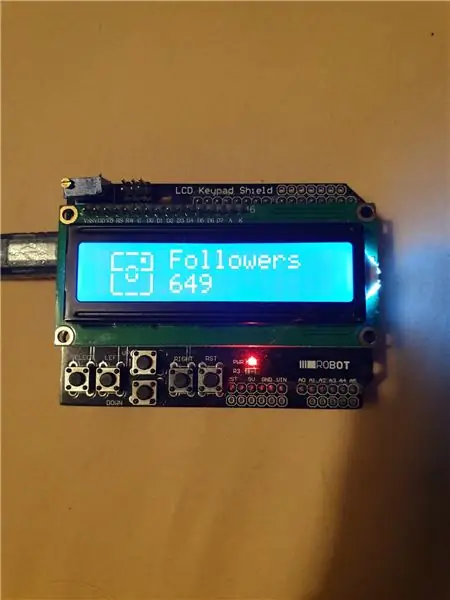

Dieses Projekt wurde zum Zählen von Instagram-Followern und YouTube-Abonnenten entwickelt.
Plattform verwendet werden:
Python
Arduino
Schritt 1: Materialien / Werkzeuge:
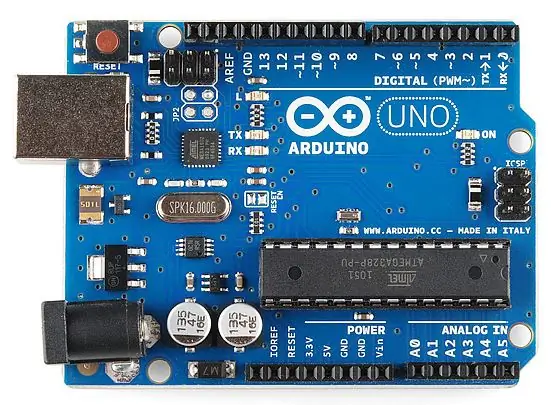
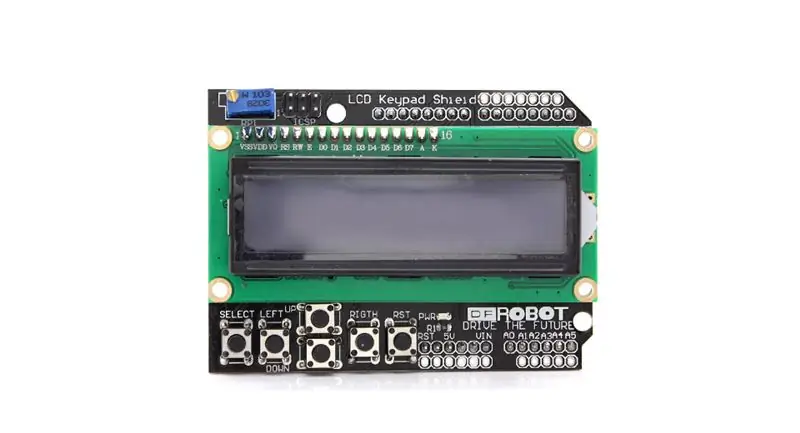
- Arduino uno
- LCD-Schild
- Programmierkabel
- Windows-PC
Schritt 2: API-Schlüssel erstellen
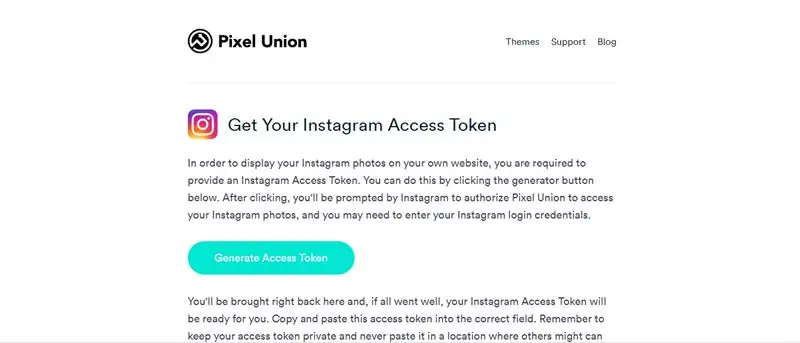
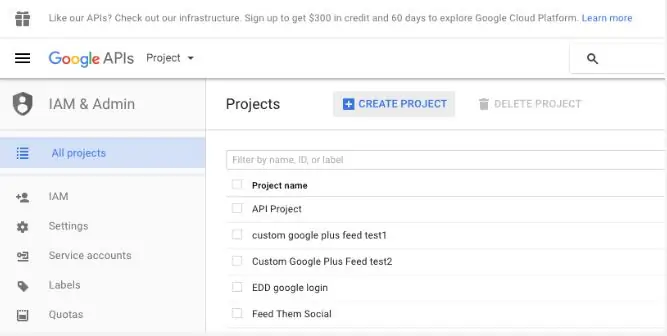
Für Instagram-Api
Gehen Sie zu dieser Website:
und Push-Zugriffstoken generieren
Für Youtube-Api
Sie können den Schritten von dieser Website aus folgen:
Schritt 3: Sketch auf Arduino hochladen
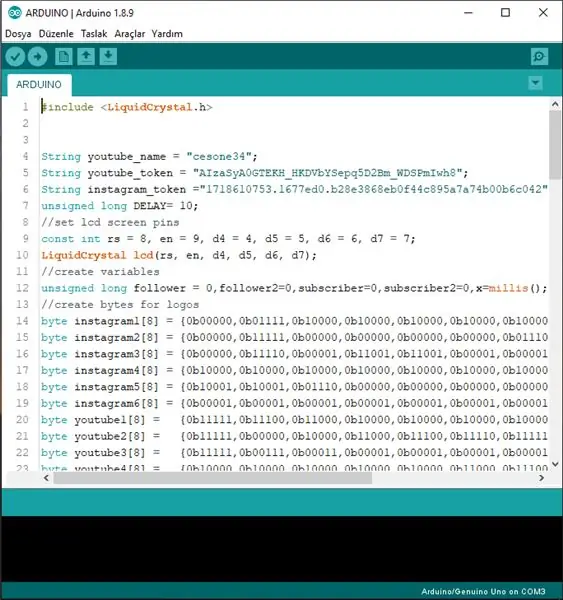
Sie können Code und Programme von meiner Github-Seite herunterladen:
github.com/ayberkeren/social-media-counter
Arduino-Code:
#enthalten
String youtube_name = ""; //Ihr YouTube-Name String youtube_token = ""; //Ihr YouTube-Token String instagram_token =""; //Ihr Instagram-Token unsigned long DELAY= 10; // Verzögerung zwischen dem Bildschirm (Sekunden) // LCD-Bildschirmstifte einstellen const int rs = 8, en = 9, d4 = 4, d5 = 5, d6 = 6, d7 = 7; Flüssigkristallanzeige (rs, en, d4, d5, d6, d7); //Variablen ohne Vorzeichen erstellen long follower = 0, follower2=0, Subscriber=0, Subscriber2=0, x=millis(); // Bytes für Logos erstellen Byte instagram1[8] = {0b00000, 0b01111, 0b10000, 0b10000, 0b10000, 0b10000, 0b10000, 0b11111}; Byte Instagram2[8] = {0b00000, 0b11111, 0b00000, 0b00000, 0b00000, 0b00000, 0b01110, 0b10001}; Byte Instagram3[8] = {0b00000, 0b11110, 0b00001, 0b11001, 0b11001, 0b00001, 0b00001, 0b11111}; Byte Instagram4[8] = {0b10000, 0b10000, 0b10000, 0b10000, 0b10000, 0b10000, 0b10000, 0b01111}; Byte Instagram5[8] = {0b10001, 0b10001, 0b01110, 0b00000, 0b00000, 0b00000, 0b00000, 0b11111}; Byte Instagram6[8] = {0b00001, 0b00001, 0b00001, 0b00001, 0b00001, 0b00001, 0b00001, 0b11110}; Byte youtube1[8] = {0b11111, 0b11100, 0b11000, 0b10000, 0b10000, 0b10000, 0b10000, 0b10000}; Byte youtube2[8] = {0b11111, 0b00000, 0b10000, 0b11000, 0b11100, 0b11110, 0b11111, 0b11111}; Byte youtube3[8] = {0b11111, 0b00111, 0b00011, 0b00001, 0b00001, 0b00001, 0b00001, 0b10001}; Byte youtube4[8] = {0b10000, 0b10000, 0b10000, 0b10000, 0b10000, 0b11000, 0b11100, 0b11111}; Byte youtube5[8] = {0b11111, 0b11111, 0b11110, 0b11100, 0b11000, 0b10000, 0b00000, 0b11111}; Byte youtube6[8] = {0b10001, 0b00001, 0b00001, 0b00001, 0b00001, 0b00011, 0b00111, 0b11111}; Void setup () {lcd.begin (16, 2); // lcd starten Serial.begin (9600); // serielle Kommunikationsverzögerung starten (2000); Serial.println (youtube_name); // Variablen zum Programmieren der Verzögerung (1000) sagen; Serial.println (youtube_token); // Variablen zum Programmieren der Verzögerung (1000) sagen; Serial.println (instagram_token); // Variablen zum Programmieren sagen}
Leere Schleife () {
if(x<(DELAY*1000)){drawinstagram(); lcd.setCursor(5, 1); lcd.print (Anhänger); Während (x0) { Follower2 = Serial.parseInt (); Subscriber2=Seriell.parseInt(); } x = Millis(); x = x%(VERZÖGERUNG*2000); } Abonnent=Abonnent2; folger=folger2; }
sonst { drawyoutube (); lcd.setCursor(5, 1); lcd.print (Abonnent); while(x>=(DELAY*1000) && Subscriber2 == Subscriber){ while(Serial.available()>0){ follower2=Serial.parseInt(); Subscriber2=Serial.parseInt(); } x = Millis(); x = x%(VERZÖGERUNG*2000); } Abonnent=Abonnent2; folger=folger2; } }
// Instagram-Logo zeichnen
Void drawinstagram () {lcd.createChar (0, instagram1); lcd.createChar(1, instagram2); lcd.createChar(2, instagram3); lcd.createChar(3, instagram4); lcd.createChar(4, instagram5); lcd.createChar(5, instagram6); lcd.clear(); lcd.setCursor(1, 0); lcd.write (byte (0)); lcd.write(byte(1)); lcd.write (byte (2)); lcd.setCursor(1, 1); lcd.write (byte (3)); lcd.write (byte (4)); lcd.write (byte (5)); lcd.setCursor(5, 0); lcd.print("Follower"); }
// youtubelogo zeichnen
Void drawyoutube () {lcd.createChar (6, youtube1); lcd.createChar(7, youtube2); lcd.createChar(8, youtube3); lcd.createChar(9, youtube4); lcd.createChar(10, youtube5); lcd.createChar(11, youtube6); lcd.clear(); lcd.setCursor(1, 0); lcd.write(byte(6)); lcd.write (byte (7)); lcd.write(byte(8)); lcd.setCursor(1, 1); lcd.write (byte (9)); lcd.write (Byte (10)); lcd.write (byte (11)); lcd.setCursor(5, 0); lcd.print("Abonnenten"); }
Schritt 4: Python
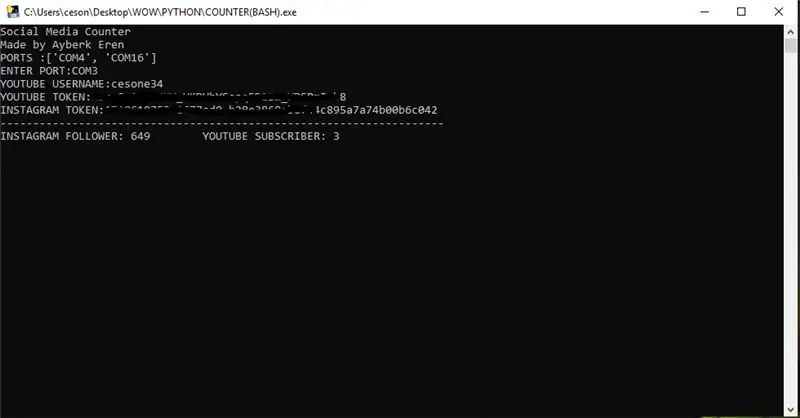

Ich habe 2 Python-Programme erstellt, eines davon hat eine grafische Benutzeroberfläche, das andere funktioniert nur unter Bash
Sie können beide verwenden, tatsächlich machen sie die gleichen Dinge.
Sie sollten wählen, welchen Port Sie Arduino aus der Liste angeschlossen haben und die Auswahltaste drücken.
und du bist FERTIG….
Laden Sie Programme von meinem Github herunter:
